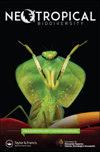厄瓜多尔西海岸城市影响区蝙蝠(哺乳动物:翼手目)软组织和骨骼中铅的定量
IF 0.8
Q4 ECOLOGY
引用次数: 0
摘要
摘要铅(Pb)对人类健康的遗传毒性影响及其在生态系统中的生物累积能力引起了全世界的关注,但目前还没有对厄瓜多尔陆地栖息地野生动物的估计。我们的目的是测定在厄瓜多尔西部瓜亚斯省城市影响地区采集的蝙蝠物种的软组织和骨组织中铅的浓度。这些标本是用雾网、从街上发现的死亡或垂死的动物身上手动捕获的,以及博物馆收藏的。我们应用Mann-Whitney U检验来分析男性和女性之间以及行会之间的差异。对66种翼手目动物进行了分析,分布在14个物种中,98.5%的物种体内存在Pb。油桃类动物的铅含量高于食虫动物和食草动物。在性别分析中,soricina舌苔、Artibeus lituratus、A.aequatorialis和Molossus Molossus的软组织没有发现显著差异。博物馆的样品使得在几个共人类物种中检测铅成为可能。最后,铅应该被认为是蝙蝠面临的新威胁,因为它可能对蝙蝠种群产生遗传毒性影响。本文章由计算机程序翻译,如有差异,请以英文原文为准。
Cuantificación de Plomo (Pb) en tejidos blandos y óseo de murciélagos (Mammalia: Chiroptera) provenientes de zonas de influencia Urbana en la costa occidental de Ecuador
ABSTRACT Lead (Pb) has generated a worldwide concern for its genotoxic effects on human health, and its ability to be bioaccumulative in ecosystems, but nevertheless, there are no estimates of wildlife from terrestrial habitats in Ecuador. Our objective was to determine the concentration of Pb in soft and bone tissues from bats species collected in areas with urban influence in Guayas province, western Ecuador. The specimens were collected with mist nets, manual capture from animals found dead or dying in the streets, and museological collections. We applied Mann-Whitney U test to analyze differences between males and females, and between guilds. 66 chiropterans were analyzed, distributed in 14 species, where 98.5% presented Pb in its body. The nectarivore guild showed highest Pb concentrations than insectivores and frugivores. In the analysis of sexes, no significant differences were found in soft tissue of Glossophaga soricina, Artibeus lituratus, A. aequatorialis and Molossus molossus. Museological samples made possible to detect Pb in several synanthropic species. Finally, Pb should be considered an emerging threat for bats due its possible genotoxic effects over populations.
求助全文
通过发布文献求助,成功后即可免费获取论文全文。
去求助
来源期刊

Neotropical Biodiversity
Environmental Science-Ecology
CiteScore
1.80
自引率
0.00%
发文量
39
审稿时长
24 weeks
 求助内容:
求助内容: 应助结果提醒方式:
应助结果提醒方式:


